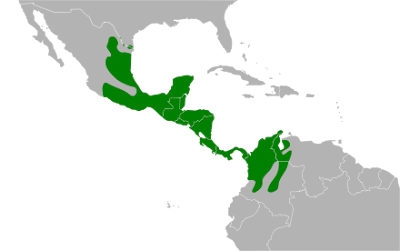There are two subspecies of flame-rumped tanager which some treat as separate species. One subspecies, often called the lemon-rumped tanager, has males that are black with a bright lemon-yellow back and rump. This subspecies is found in most of the range which runs from portions of Panama, Colombia, and Ecuador into northern Peru. I saw lots of them in Ecuador last year and posted on it
here.
 |
| This is a female yellow-rumped tanager seen in Ecuador. |
 |
| This is a male yellow-rumped tanaager seen in Ecuador. |
The flame-rumped subspecies, the nominate subspecies, looks similar to the lemon-rumped, but flame-red-scarlet replaces the lemon-yellow. Its distribution is much more limited. It is only found in Colombia in parts of the Departments of Antioquia, Caldas, Risaralda, Quindio, Valle Del Cauca and Cauca, mostly on the eastern slopes of the West Andes and the western slopes of the Middle Andes.
 |
| This is the range of the flame-rumped tanager subspecies, all in Colombia - from Wikipedia. |
 |
| This is a map of the Colombian Departments - from Wikipedia. |
I saw photos of them last year when we were in Ecuador and wanted to see them. Fortunately, that wish came true this year! On the margins of the range there is interbreeding between the two subspecies. Tinamu Reserve is in the Department of Calda and Montezuma Rainforest Lodge is in the Department of Risalda, but I'm not certain where they fit into the mapped range. However, we saw yellow-rumped and flame-rumped tanagers at Montezuma and I believe we saw mixtures of the two at both Montezuma and Tinamu.
 |
| This female yellow-rumped and the male below, were seen at Montezuma. |
 |
| This and the following four photos are flame-rumped tanagers at Montezuma, or at least crosses, because they do have some yellow. |
 |
| I believe this is a cross because it has both yellow and red. |
 |
| This and the next two photos are of the same bird at Tinamu. I'm not sure if it is a full flame-rumped or a cross. |
 |
| This is a female and looks like a full flame-rumped tanager. The next photo is of the same bird. |
The flame-rumped subspecies is prettier than the lemon-rumped subspecies.























































